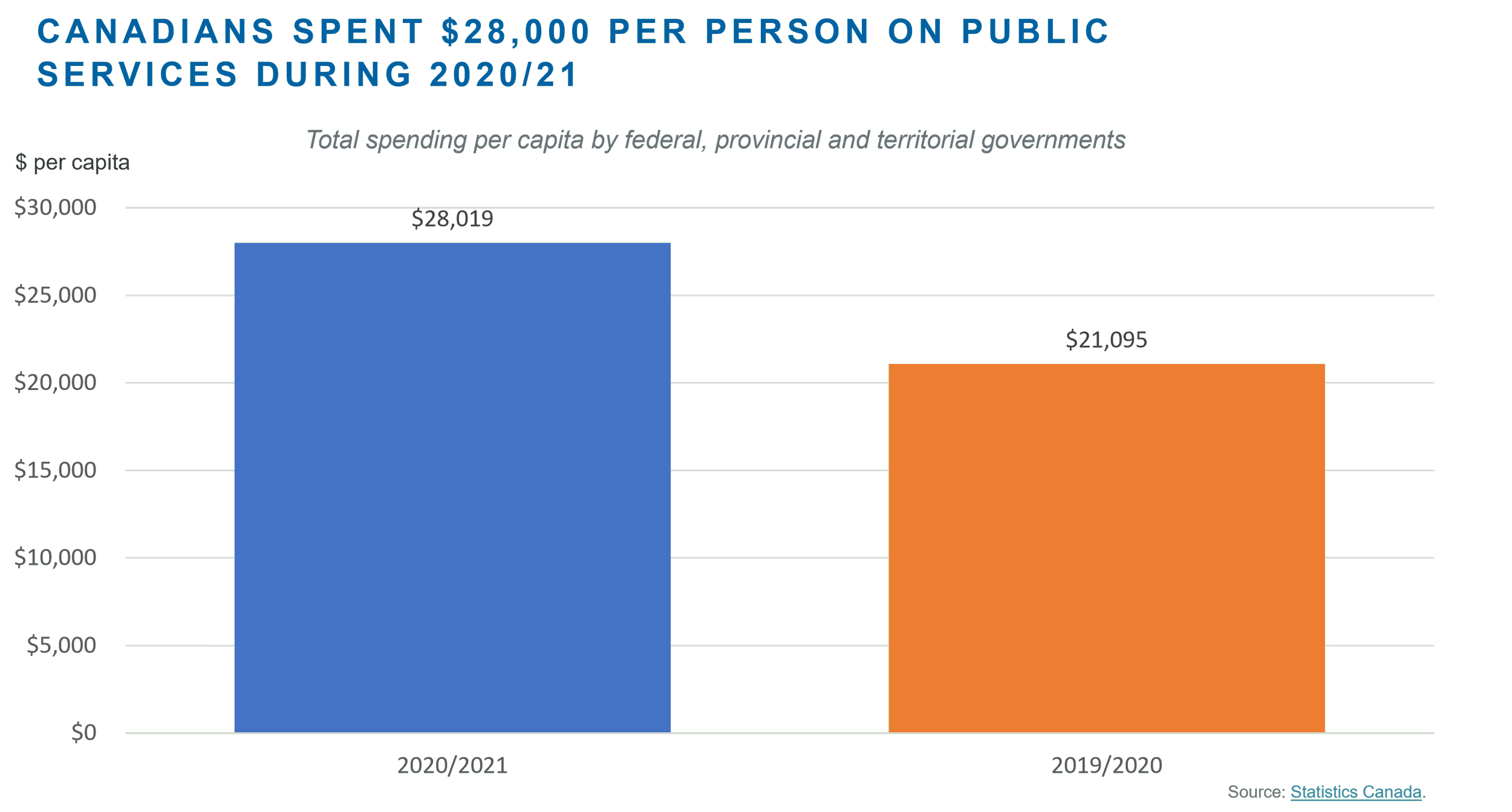Canadians spent $28,000 per person on government services and supports in 2020/21
Recently published Statistics Canada data show that all levels of government – including federal, provincial and territorial governments across Canada – spent $28,000 per capita on public services and income supports during 2020/21 (Figure 1). That works out to $76 per person per day. It represents a one-third increase on 2019/20 when Canadians spent $21,000 per capita, or $58 per person per day, on public services and supports.
Figure 1
Comparing levels of public spending and private incomes
Much of the extra spending during the COVID-19 pandemic was funded by issuing vast amounts of new federal government debt. A significant share of that debt was purchased by the Bank of Canada through its quantitative easing programme. As noted in a BCBC report last year, Canada’s increase in public and private borrowing during the pandemic was amongst the largest in the world.
Nevertheless, the median household market (pre-tax) income across Canada in 2019 was $85,600 per family and $58,000 per unattached individual. This means the level of public spending per capita in 2020/21 was equal to approximately one-third of family incomes, up from a quarter in 2019/20. Meanwhile, for single-person households, public spending per capita was equal to half of income, up from one-third in 2019/20.
What are governments spending on?
The largest increases in public spending during 2020/21 were around social protection and economic affairs (Figure 2). Various income support programmes, mostly at the federal level, were rolled out to help workers and businesses endure the economic downturn and the public health restrictions imposed by provinces to slow the spread of COVID-19.
Health spending is the second largest area of public spending. Surprisingly, there was a relatively modest 21% increase in such spending during the pandemic to $5,732 per capita. Note that B.C.’s spending on health during 2020/21 was the second lowest among the provinces at $5,372 per capita (Figure 3). This may reflect the B.C.’s government’s decision to cancel or defer many non-essential medical procedures during the pandemic to relieve pressure on hospital acute care capacity.
The cost of government administration (general public services) was around $3,500 per capita, increasing by 12% relative to the previous year (Figure 2). Education spending cost almost $3,000 per capita, slipping from fourth to fifth place in 2020/21. Another notable finding – especially as Ukraine attempts to repulse an invasion by the Russian military – is that Canadians spend very little on defence and security at just $600 per capita. Governments are also spending comparatively small sums on environmental protection ($400 per capita) and housing ($300 per capita).
Figure 2
Figure 3
Conclusion
COVID-19 saw a massive one-third increase in public spending to $28,000 per capita in 2020/21. While temporary income supports for households and businesses were necessary, loose fiscal policy is not sustainable. Runaway consumer inflation – 7.5% y/y in the U.S. and 5.1% y/y in Canada as at January 2022 – almost certainly spells the end of extraordinarily loose monetary policy by the world’s major central banks. Interest costs on public and private debt are set to rise. As the COVID-19 pandemic ebbs, governments across Canada will need to start thinking about how to pare back spending – necessitating judicious, outcome-based assessments and choices about which programmes to keep – and consolidate public debt.
A recent BCBC report highlighted some bleak projections by the OECD. Canada is projected to deliver the lowest growth in real GDP per capita among 38 advanced countries over 2020-30. The OECD not only expects Canada to be worst performing economy in the advanced world for the decade to 2030, but also for the three decades after that – from 2030-60. This means that average incomes and living standards in Canada are set to stagnate in absolute terms and decline relative to other major countries. This rather sobering assessment was discussed in a recent Globe and Mail column. Growth in B.C.’s real GDP per capita is close to the national average, so similarly grim prospects can be inferred for B.C.’s economy on a per capita basis. The corollary is that with poor prospects for improving per capita incomes, Canadians and our governments may soon have to rein in per capita public spending and start to live within our means.
Also see BCBC's full 2022 B.C. Budget analysis.



